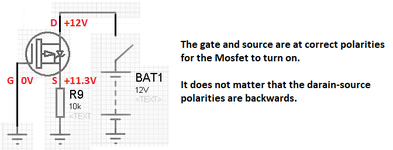pete16
Junior Member level 1

Hello
Looking at the image will the P-Channel Mosfet conduct through the channel , through the body diode or both after the switch is turned on?
Assume Vgs threshold is -1.2V. and the switch is initially off.

Looking at the image will the P-Channel Mosfet conduct through the channel , through the body diode or both after the switch is turned on?
Assume Vgs threshold is -1.2V. and the switch is initially off.



